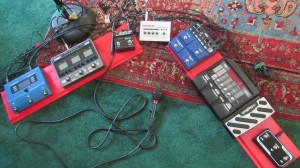
What Works at a Jam Session
I jammed with some friends at a party in Driggs, Idaho on Saturday night (August 24). The musicians I played with weren’t spectacular, or even professionally competent in some ways, but it was a really enjoyable jam session. At some points, the combined sound of the players was truly exciting, to an extent I really hadn’t expected. It made me wonder about the things that make for a good jam. Here are the three things I think of first in that regard.
The first thing is attitude, which is expressed most strongly by how much and how well a player listens.
These guys listened. They did their best to learn new tunes on the spot, and when they locked onto a groove they held it. They weren’t virtuosos, but they avoided all the common mistakes, like playing too much or playing over each other or playing stuff their fingers or minds couldn’t handle. They played their parts, mostly simple ones, solidly.
Listening makes a bigger difference than anything else in a jam session; a jam is really all about how the musicians relate to each other in the moment. These guys related.
If you start with the attitude that you’re there to make the band sound better, a lot of other things, like listening carefully, tend to fall into place. If you start with the attitude that you’re there to show everyone how incredible you are, then you’d better hope everybody else isn’t running the same game, because everyone will be fighting for all the space, all the time. Better to listen and find the places where you can make a difference without derailing everyone else.
The second thing is knowing the tunes and the style.
It’s tough to really play something great if you don’t know the structure of the piece you’re playing or what kinds of moves work in the style that the piece represents. These guys didn’t know all the tunes, but they watched and listened for the structures, and they got them on the second try at least in most cases. They certainly knew how to rock.
The third thing is being prepared to play.
That means being sober, or at any rate not too stoned to handle your instrument. (Sober is best. Will Lee pointed out years ago in an interview in Keyboard magazine that the essence of the drug experience is alienation. Alienation can be fun, but it definitely does not improve your ability to relate to other musicians, or anyone else, so it’s worth nothing in a jam session.) It means being reasonably in practice. It also means that you have the gear you need for the performance, it works, and it can be set up as close to instantly as possible. Nothing says “novice” like fumbling around trying to get your gear set up while the audience loses interest and walks away.
It’s not a bad idea to have different versions of your setup for different situations. I used my quick-setup rig for this gig: harp into Audix Fireball, Fireball (wired) into RP355, RP355 into JamMan Stereo looper, looper into Peavey KB2 amp. I carry the RP355 and looper set up on a board that I can just put down on the floor, more or less ready to go.

I didn’t put the amp through the PA because I didn’t need to in this case; I had plenty of volume and presence in the room without it. But if I had needed to, I was prepared to run a cable from the looper to the board. I also had to set up a power strip and a pair of power supplies for the RP355 and the looper. I finished the setup in less than 10 minutes.
If I’m playing in an open mic, I need to get the setup down to 5 minutes or less; if I’m playing in a jam session at a bar, 2 minutes or less is tops. That means that I can’t bring the RP355 and looper to a jam session at a bar, because it takes too much time to set up both the audio and power connections; for such events I use the Tech 21 Blonde pedal or the Zoom G3, either of which runs on batteries, meaning setup consists of plugging a mic in and a line out to the PA. I make sure to carry a looooong 1/4″ cable to any jam, because I never know how long the cable run to the board will be.
Knowing how to set your gear up and get a good sound, almost instantly, tells everyone in the band that you’re not a novice. Being sober tells them that you’re serious about your performances.
There’s more to jamming than these things, of course. These are very basic things. But the fact is that the basics take you a long way. They certainly took the guys I played with Saturday night a long way. I’m going to remember that session.
Related Posts
Leave a Reply
You must be logged in to post a comment.
WHAT’S NEW
Categories
- Audio/Video
- Blog
- Blue Future
- Digitech RP Tricks and Tips
- Discography, CDs, Projects, Info, Notes
- Featured Video
- For the Beginner
- Gallery
- Hunter's Effects
- Hunter's Music
- Huntersounds for Fender Mustang
- Meet the Pros
- More Video
- MPH: Maw/Preston/Hunter
- My Three Big Contributions
- Player's Resources
- Pro Tips & Techniques
- Recommended Artists & Recordings
- Recommended Gear
- Recorded Performances
- Reviews, Interviews, Testimonials
- The Lucky One
- Uncategorized
- Upcoming Performances
- Zoom G3 Tips and Tricks